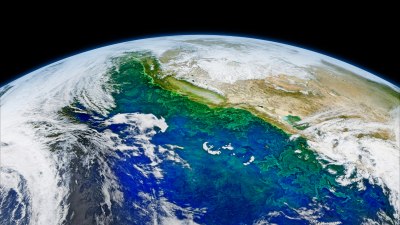What If Earth’s Atmosphere Was Twice as Thick How Weather Would Evolve
Explore the implications of a thicker atmosphere on Earth’s weather patterns and climate.

Image by rawpixel-com on Freepik
If Earth's atmosphere were twice as thick, it would fundamentally alter weather systems, climate patterns, and even the biosphere's interactions with elements.
To begin with, a thicker atmosphere would increase air pressure. Atmospheric pressure has a significant effect on weather. With higher pressure, density increases, which could lead to a reduced rate of evaporation. This change would mean that the water cycle might be less efficient, leading to fewer rain events in some areas and potentially more arid conditions overall.
The increased atmospheric thickness may also have effects on the distribution of energy from the sun. With more atmosphere to penetrate, solar radiation would be scattered more, possibly resulting in cooler average temperatures on Earth's surface, particularly at the equator. This could lead to a more uniform climate across the globe, with less drastic temperature gradients between the poles and the equator.
Implications for Weather Patterns
The alteration in temperature distribution would inevitably influence wind patterns. Winds are largely driven by temperature differentials; hence, with a more uniform climate, wind speeds might decrease. Slower winds could lead to stagnant air in many regions, which might exacerbate air quality issues due to pollution. Furthermore, a reduction in wind movement would influence the speed at which weather systems move across the planet, leading to more prolonged weather conditions, such as extended droughts or continuous rainy spells.
Storm systems such as hurricanes and cyclones could also be affected. Currently, these systems rely on warm ocean waters and the Coriolis effect, which creates rotation. A thicker atmosphere might change how heat is distributed over oceans, possibly resulting in fewer, less intense storms, or, conversely, in more energy being trapped, leading to a potential increase in storm occurrences but with less cyclonic activity.
Effects on Precipitation
The nature and frequency of precipitation would likely change as well. With increased atmospheric water vapor capacity due to higher pressure, when rain occurs, it could lead to heavier downpours. This might increase the risk of flooding events in some regions while leaving others drier, depending on prevailing weather patterns.
Furthermore, snow formation would also evolve. Warmer air combined with thicker atmosphere might result in more rain falling in winter months instead of snow, dramatically altering ecosystems that rely on snow cover for hydration during spring melt.
Biosphere Responses
The flora and fauna adaptations to a twice as thick atmosphere would be significant. Plants use photosynthesis to convert sunlight, and an increase in carbon dioxide, a byproduct of human activity, could see an initial boost in growth rates. However, with changes in temperature and weather patterns, stress on plant species could also increase, challenging their resilience. Plants accustomed to current water availability might struggle in a higher atmospheric pressure scenario.
Animal life would similarly be affected. Species that rely on specific climates would face increased challenges, potentially leading to a decline in biodiversity in certain ecosystems. Adaptations in behavior, diet, and habitat preferences would emerge as species attempt to survive under these altered conditions.
Climate Change Feedback Loops
One of the critical considerations in a thicker atmosphere scenario is how feedback loops would manifest. Increased moisture retention could enhance the greenhouse effect, leading to even higher temperatures. This feedback mechanism could create a cascade of effects, leading to drastic shifts in climatic conditions, which are difficult to predict accurately due to the complex interactions within Earth's systems.
Geophysical Changes
The geology may also experience alterations. Aquifers might see reduced recharge rates due to changes in precipitation, and water tables could become lower if evaporation decreases, destabilizing agricultural systems. Alongside that, alterations in sea levels due to fluctuating temperatures might create unsustainable habitats for coastal ecosystems.
Potential New Weather Phenomena
With a thicker atmospheric layer, we could also encounter novel weather phenomena that are currently non-existent. Abundant moisture and pressure fluctuations might lead to new cloud formations and types, influencing weather forecasting. The distribution of these clouds could create variations in sunlight penetration, further complicating agriculture, and impacting energy production.
Long-Term Consequences
In the long term, the biosphere may adapt more holistically to the new atmospheric conditions, leading to the emergence of resilient ecosystems that may look notably different compared to today’s Earth. Specific adaptations in flora and fauna could also evolve, potentially leading to new species development spurred by the changing climates and habitats.
The socio-economic implications of such a transformation are profound. Agriculture would require industry-wide adaptations, potentially increasing food prices and creating food insecurity in many regions. Migratory patterns of humans may change as certain areas become inhospitable, leading to population shifts that could strain resources elsewhere.
While a thicker atmosphere could provide some benefits, such as increased humidity and potentially greener landscapes due to enhanced plant growth, the overall implications for weather and climate would be complex and demanding. Understanding these dynamics and preparing for such scenarios would be critical for maximizing benefits while mitigating adverse effects. Our grasp of Earth’s systems helps frame how interconnected these processes are, and a drastic change like a thicker atmosphere would highlight the fragility of our environment.











